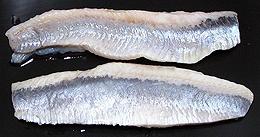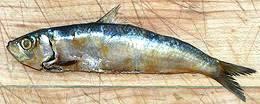 [Family Clupeidae, various genera and species]
[Family Clupeidae, various genera and species]
Herring are a family of generally small oily fish of tremendous commercial importance worldwide. Herring can grow to over 18 inches and 1.5 pounds but is generally caught and harvested much smaller. See also Sardines for smaller varieties of Herring.
More on Fish Varieties
(very large page).
 [Clupea harengus harengus]
[Clupea harengus harengus]
The most abundant and economically important herring, this round bodied fish can grow to nearly 18 inches and 1.5 pounds but the photo specimen was 13-1/2 inches and weighed 14-3/4 ounces, pickled whole. Atlantic herring is commonly sold pickled or smoked but is eaten raw in Holland and fresh in Northern Europe, particularly Poland.
Very small immature herrings and often called "whitebait, and are
generally eaten whole. Sild are small immature herrings canned like Sardines
in Norway. Marine ecologists classify Atlantic herring as a sustainable
harvest. Details and Cooking.
 [Cá Trích (Viet); Clupea pallasii]
[Cá Trích (Viet); Clupea pallasii]
The Pacific Herring is very similar to the Atlantic Herring. It's a round
bodied fish that can grow to 18 inches and 1.5 pounds but the photo specimen
was 14-1/2 inches and weighed 14.6 ounces, whole, thawed from frozen. IUCN
Red List DD (Data Deficient) but is not thought to be threatened.
Details and Cooking.
 [White Shad; Alosa sapidissima]
[White Shad; Alosa sapidissima]
This is an amazingly delicious fish - for experienced fish eaters, as will be explained. It is native to the east coast of North America, from the St Lawrence river, Newfoundland and Nova Scotia, south to central Florida, but less common south of Virginia. Some are also found on the north coast of the Gulf of Mexico. Due to introduction, it is now also found from the south coast of Alaska to The Mexican Border of California, and along the Russian Kamchatka Peninsula.
It can grow to 30 inches and 12 pounds, but the photo specimen,
purchased from an Asian market in Los Angeles, was 20-1/4 inches and 3
pounds 3 ounces - still pretty big for a herring. Unfortunately, it was
sold already scaled, so it should be more silvery. This fish is more
closely related to European shad than to other North American shad.
It is not considered endangered, IUCN Red Listed LC
(Least Concern).
Details and Cooking.
 [River Anchovy (marketing); Ca Com Song (Viet); Trey bawndol ampeou
(Khmer); Corica Laciniata]
[River Anchovy (marketing); Ca Com Song (Viet); Trey bawndol ampeou
(Khmer); Corica Laciniata]
This fish is native to rivers, estuaries and lagoons opening into the Gulf of Thailand, also in the Mekong Basin and in rivers of southern Borneo, Indonesia. It can grow to 2-3/4 inches, but the photo specimen was 2.16 inches. Largest in the batch was a giant, 2.4 inches long.
These fish are extremely delicate, and it was difficult for me to
find a specimen in the tray without its belly burst open. I did not try
to extend the pelvic fins, which you can see the tips of at the back end
of the belly, for fear of bursting it open.
Details and Cooking.
 [Skipjack Shad, Alosa chrysochloris]
[Skipjack Shad, Alosa chrysochloris]
While most herring are found in cold ocean waters this one likes subtropical
temperatures and ventures far up rivers, having been found as far north
as Minnesota in the Mississippi and Ohio rivers. This fish can grow to
19 inches and 3-3/4 pounds the photo specimen, caught wild off Florida,
was 9-1/2 inches and weighed 5 ounces.
Details and Cooking.
 [Ethmalosa fimbriata]
[Ethmalosa fimbriata]
This is a very important fish in West Africa. It is found from Western
Sahara south to northern Angola. Traditionally it was hot smoked until
very dry for storage. Today, as ice becomes available in West Africa, it
is becoming popular unsmoked.
Details and Cooking.

Herring is an oily fish that preserves well in various ways, and all
these ways are exploited. The photo shows two pickled herring fillets
from Lithuania, a significant exporter of such seafood treats since
the fall of the Soviet Union. Yummm! More on
Preserved Herring
 [Kapenta, Matemba (Zambia, Malawi, Zimbabwe); Limnothrissa miodon
(Lake Tanganyika sardine) | Stolothrissa tanganicae
(Lake Tanganyika sprat)]
[Kapenta, Matemba (Zambia, Malawi, Zimbabwe); Limnothrissa miodon
(Lake Tanganyika sardine) | Stolothrissa tanganicae
(Lake Tanganyika sprat)]
These fresh water herring are very important to Zimbabwe, Zambia and Malawi.
They originated in Lake Tanganyika, but have been successfully introduced
into other large lakes in Southern Africa. Adults average around 4 inches
long, and the catch us usually sun dried.
Details and Cooking.
 [Tyulka, Kilka (Russ); Black Sea Sprat, Clupeonella
cultriventris - Similar: Anchovy Kilka, Anchovy Sprat
(fishbase), Clupeonella engrauliformis, and (lesser importance)
Bigeye Kilka, Southern Caspian sprat, Clupeonella grimmi]
[Tyulka, Kilka (Russ); Black Sea Sprat, Clupeonella
cultriventris - Similar: Anchovy Kilka, Anchovy Sprat
(fishbase), Clupeonella engrauliformis, and (lesser importance)
Bigeye Kilka, Southern Caspian sprat, Clupeonella grimmi]
Cultriventris is a brackish to fresh water fish native to the Black, Azov and northern Caspian Seas and nearby lakes and rivers, while grimmi and engrauliformis live in central and southern Caspian only. All can grow to just over 5-1/2 inches, engrauliformis a little longer, and are major fish for canning in the region. I have also seen some cans of Latvian Baltic sprats labeled Kilka, but that isn't right. The photo specimen, which was salt pickled, was 5 inches long and weighed 3/4 ounce. The largest in the batch was 6 inches and weighed 1-1/8 ounces.
Caspian stocks have recently dropped 50% due to an American comb jelly
named Mnemiopsis leidyi eating all their food, so the fishery is
now endangered. This also happened to the Black Sea but another American
jellyfish named Beroe ovata came along and ate most of the
Mnemiopsis. This solution is likely to be applied in the Caspian.
Beroe eats mainly other Comb Jellies, and disappears when they
are all eaten.
Details and Cooking
 [Pacific Thread Herring; Opisthonema libertate -
Atlantic Thread Herring; Opisthonema oglinum]
[Pacific Thread Herring; Opisthonema libertate -
Atlantic Thread Herring; Opisthonema oglinum]
These fish are named for the last ray of the dorsal fin which reach
near the end of the tail. Unfortunately this thread doesn't survive
freezing and handling, so there is only a short stub on market fish.
The Pacific species is found from San Pedro (Los Angeles) California
south to Peru, but is rare on the outer coast of Baja California.
The Atlantic species is found from Maine through the Caribbean and
Gulf of Mexico to northern Brazil. The Pacific can grow to nearly
12 inches, but the photo specimen, purchased from a Philippine
market in Los Angeles, was 10 inches long and weighed 5-1/4 ounces.
The Atlantic can grow about an inch longer.
Details and Cooking.

These three fish are all but indistinguishable one from another. They
are highly commercial Indo-West Pacific fish found from the Persian
Gulf to the South China Sea and the Java Sea, these fish can grow to
over 23 inches inches (14 inches for kelee) but the Hilsa specimen in
the photo was 10 inches and weighed 6 ounces. These shad are marketed
fresh and dried and are not considered threatened. Farming Ilish /
Hilsa is in the development stages in India (2012 - 2014). This is
considered a very desirable fish in West Bengal and Bangladesh,
and is the national fish of Bangladesh.
Detais and Cooking
 [Genus Sardinella various species and Dussumieria acuta]
[Genus Sardinella various species and Dussumieria acuta]
Tunsoy is the Philippine name for various Indo-Pacific herring. The
photo specimen, from a package of salted and dried herring obtained
from a Philippine market in Los Angeles, was rehydrated by soaking
in water for 20 hours (yes it took that long to soften it up). It
was 4-3/4 inches long and weighed 0.35 ounce rehydrated. This fish
was eviscerated before drying in compliance with California health
law. Details and Cooking.